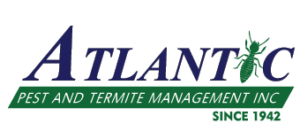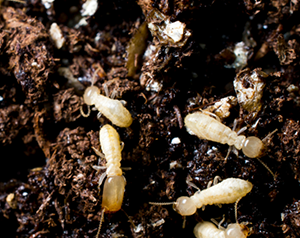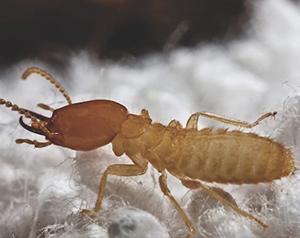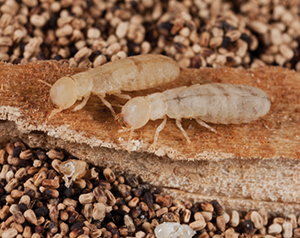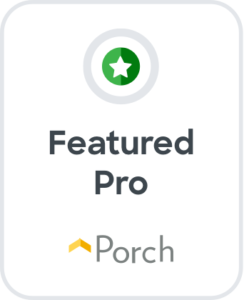![]() Here at Atlantic Pest and Termite Mgmt., our goal is to provide you with the least invasive treatment options available in the industry. We use both baits and liquid treatment methods to protect your investment. We are proud to use the Sentricon® Termite Colony Elimination System with Always Active Technology that provides 24/7 protection for your home. What are the benefits of this system?
Here at Atlantic Pest and Termite Mgmt., our goal is to provide you with the least invasive treatment options available in the industry. We use both baits and liquid treatment methods to protect your investment. We are proud to use the Sentricon® Termite Colony Elimination System with Always Active Technology that provides 24/7 protection for your home. What are the benefits of this system?
- It is the number one brand in termite protection.
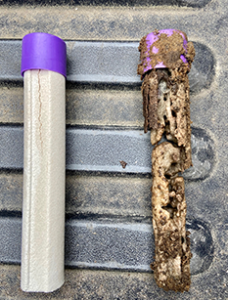
A new Sentricon termite colony elimination bait station vs one that has had termite activity.
- It eliminates termites at the source and destroys the entire colony.
- It is a green and eco-friendly solution to eliminating termites.
- It is not disruptive to your home whatsoever!
The Sentricon® Termite Colony Elimination System, is the first and most successful termite baiting system, has been proven to eliminate termite colonies by independent research at 30 universities, reported in 45 published scientific articles, and by the U.S. Department of Agriculture. It uses only a few grams of active ingredient in a specialized bait matrix that termites love to eat. Contained in plastic bait stations, the Recruit™ bait is strategically placed in the ground around your home, creating a complete barrier of protection. Termites feed on the Recruit™ termite bait and share it with nestmates until the colony dies. The Sentricon® Termite Colony Elimination System requires no drilling in floors or foundations, no digging or trenching and no chemicals being injected into the soil.
Atlantic Pest and Termite Mgmt. integrates the Sentricon® Termite Colony Elimination System with traditional treatment and the most advanced technology to provide complete control of termites. Atlantic Pest and Termite Mgmt. is proud to be an Authorized Operator of the Sentricon® Termite Colony Elimination System.
A Family Thing
A look into experience, expertise and why the Sentricon® system are critical components of successful Formosan termite treatments, as told by our owner, Hunter Ford during an interview with Corteva.
Read blog post here.
SIGNS YOU MAY HAVE TERMITES
Scientific Name: Reticulitermes Flavipes
Family: RhinoTermitidae
Size: 1/4″ to 3/8″
Color: Very light to medium brown
Colony Size: 150,000 to 1,000,000
EASTERN SUBTERRANEAN TERMITES
The subterranean termite is by far the most destructive termite. These termites live in colonies underground and also in moist, secluded places above ground. Their colonies are divided by: worker, reproductive and soldier. Workers do all of the damage by eating wood and feeding the rest of the colony. Soldiers defend the colony against predators, such as ants. In the spring, swarms take place and the reproductives go on to form new colonies. Their colonies are vast and can have as many as a million members!
Scientific Name: Coptotermes Formosanus
Family: Rhinotermitidae
Size: 1/8″ to 3/8″
Color: Very light to medium brown
Forage Area: 300 feet
Eggs Laid: 2,000 per day (single queen)
Colony Size: 350,000 to 3,000,000
FORMOSAN TERMITES
The Formosan termite is also known as the “super termite” for its destructive capabilities. Their colonies have an average size of 350,000 members but can number in the range of several million! Within 25 days, an average colony of Formosans can consume one foot of 2×4 wood. These termites are known to infest not only structures, but also shrubs, live trees and even boats. They can chew through wood, flooring and wallpaper without notice. Formosans will readily infest from above ground when moisture is present.
Scientific Name: Kalotermitidae
Family: Rhinotermitidae
Size: 1/8″ to 3/8″
Color: Very light to medium brown
DRYWOOD TERMITES
These particular termites do not prefer moist wood like the Eastern Subterranean or the Formosan. Instead, they prefer dry wood like you would find in attic joists or supporting structural walls. The damage these critters can cause can get pretty expensive pretty fast without you even knowing it. Their colony size is small compared to the two other species discussed, only averaging 2,500 members per colony. A scary thing about these termites is their ability to be spread through secondhand furniture and picture frames! So, when bringing used furniture into your home, inspect it!
KNOW THE DIFFERENCE
Subterranean termites “swarm” as the weather begins to warm, usually at the beginning of spring, often following a rain. Termite swarmers can often be confused with Carpenter Ants. Both insects damage wood in your home, but not in the same way. For termites, wood is food. For Carpenter Ants, wood is home. Both infestations are complex problems and getting rid of each kind of pest requires specialized equipment to deliver specific treatments.
 TERMITE SWARMER
TERMITE SWARMER
Straight bodies
Straight antennae
Wings the same length
Usually brownish in color
 CARPENTER ANT
CARPENTER ANT
Pinched in waists
Bent antennae
Two sets of wings, one shorter than the other
Can be black, red, brown, yellow, orange, or red and black
